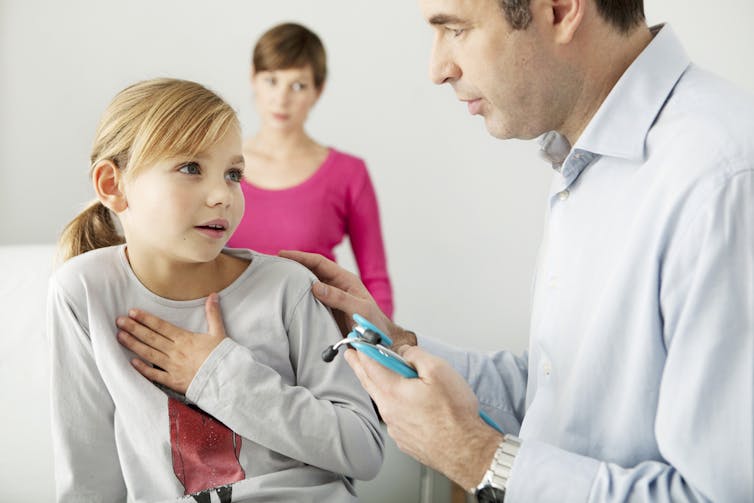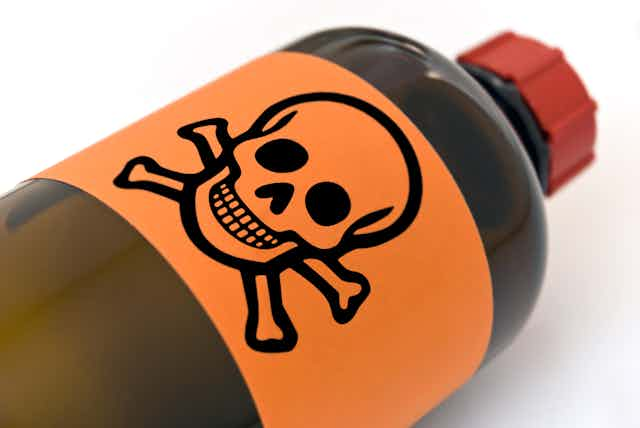Media reports have emerged of psychotic episodes in children brought about by a common asthma medication, Singulair. The Therapeutic Goods Administration (TGA), which approves and monitors drugs in Australia, has apparently received 90 reports of psychiatric events.
So this leads to the question of how drugs are approved, and whether we are all at risk of harmful side effects from the medicines we take.
This issue is more complex than telling everyone about every possible side effect. First, there is no way to predict if an individual will be affected until they try the medication.
Second, to do so would be a scare campaign – as a pharmacist, I can scare anyone off taking anything if I put my mind to it, but that’s not my job. My job is to weigh risk and benefit – and taking any medication is a calculated risk.
How are side effects determined?
The list of side effects on the product information inside your medicine boxes is determined during clinical trials. Patients in the trial are monitored and regularly asked to report all symptoms they experience. At this stage, neither the patient nor the doctor knows if the patient is on the real (active) drug or the placebo.
All the reported symptoms are recorded and hence side-effect lists are developed, even if just one of the patients suffers this particular side effect once, and without knowing if they are in the active or placebo group.
The big thing missing in this recording process is causality – did the drug cause the effect, or was it coincidence?
For rare effects, the study size will probably not be large enough to pick them up. For example, a side effect that occurs in one in a million patients would be detected only about nine times if the entire Australian population (almost 18 million adults in 2015) was split into active and placebo groups for a trial.
So how do we find out about these effects? It happens through “pharmacovigilance”, or watching what happens once the drug is used in the general population. Only then will the rare things be seen. The Singulair® case is an excellent recent example of this – the company says tens of millions of patients have taken the drug (around the world), but the Australian market is much smaller.
The active drug in the medication, montelukast, has been available in Australia since 2000, and on the PBS since 2003. From listing in 2003 to December 2015, just over 2 million prescriptions for it have been dispensed. (Available statistics do not determine number of patients, or show figures from 2000-2003 when it was a private prescription not on the PBS.)

To put the new reports in context, the TGA received 90 reports of psychiatric events in just over 16 years. Out of these 90 reports, 16 were related to the specific event highlighted in the report (suicidal thoughts and depression). So 16 cases in over 2 million prescriptions makes this a truly rare effect.
This is not to make light of the seriousness of these effects for the people involved. Ideally, these effects would not occur. However, expecting such rare events to be included on warnings is not feasible. It was listed, however, on the medication product information.
When are warnings warranted?
To determine if an effect is caused by a drug, the pharmacovigilance experts at the TGA need to filter the “signal” (drug-caused) effects out from the “noise” (same effect occurring in the population without the drug).
A US study showed the rate of non-fatal suicide attempts in ten- to 17-year-olds was 197 per 100,000 people over a five-year study period. Fatal suicide was 6.4 per 100,000. While the same data aren’t available in Australia, we can use the US data as a rough benchmark.
If we assume (albeit unrealistically) the 2.049 million scripts were evenly spread over the 12 years and each patient took the drug continuously for that period (one prescription per month), then the number of prescriptions equates to a low estimate of 14,299 patients. The US suicide study was conducted over five years, so the annual incidence of non-fatal suicide attempts would average 39 people per 100,000 people.
Using data from the media reports, there was approximately one report (16 reports over 16 years) of suicidal ideation or depression per year per 14,229 patients. That’s an incidence of seven per 100,000 people per year, yet the US data show a “background” rate of 39 per 100,000 people per year. Therefore it can be difficult to find this “signal” within the background “noise”.
Drug risks and benefits
The TGA has determined a likely connection between the drug and the psychiatric events, so parents of affected children are asking why they weren’t warned. I answered this earlier – it’s all about risk and benefit. If patients (or their parents) were provided with a list of every side effect, many people would be scared off taking useful medicines.
Unfortunately, the Australian population (generally) does not have sufficient health literacy to be able to put such information into context – look at the anti-vaccination and other scare campaigns. Health professionals are usually time-poor and often do not do the best (or even a good) job explaining the potential side effects to patients.
Patients should be empowered and encouraged to ask questions and discuss risks and benefits with their health-care professionals, about a range of issues, not just medication.
Sometimes an effect is deemed by the TGA to constitute a major risk to the public and a specific warning is attached to product information and even the packaging. These effects pose a significant risk to health and occur with a frequency that warrants such warnings. There are no hard and fast cut-off values. Like most things in the medical world, it’s about judgement and shades of grey.
The information available at the time of prescribing or starting a medicine is often not complete, so the risk-benefit balance is not a certain science. Health professionals must ethically have their patients’ best interests as their primary concern, but when we try a medicine we need to watch carefully to see if it works for that individual.
Yes, some side effects can be scary, but put in the context of the good medicines can do, judgement calls need to be made. People make risk-benefit decisions throughout daily life, such as crossing the road, driving a car and other dangerous daily tasks.
Medical decisions are no different, but people feel less empowered because a product is recommended by an “expert” or they do not have sufficient knowledge to make an informed decision. This is why it’s important for patients to empower themselves by asking questions and making all decisions shared.

